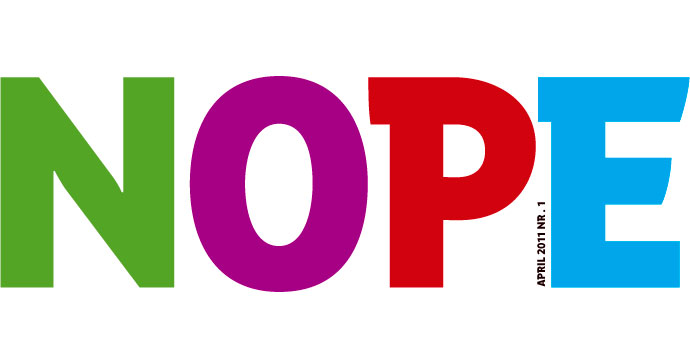
- Contact the Development Department of EAA.
- Present a preliminary plan. It should contain, 1) the problem to be solved, 2) your project goal, 3) which EAA department could possibly help and 4) other specialties which may be involved and 5) any deadline. It should be mentioned that you may want to obtain the support of the EAS (Enterprise Estonia) Innovation program.
- Seek agreement with the Development Department representative, set a time for a meeting where you can present your plan for working together, the budget and your planned financing strategy.
- Sign the contract for working together
- If necessary complete a financial support application and the work on the project can begin!
- EAA will report to the service recipient, make summaries and the results will be presented to them.
- There will be a joint marketing of the joint effort results.
Source: EAA Department of Development
* EAA offered services can be found in the catalogue accessed at coop.artun.ee
The list of services is open to all for viewing. The catalogue gives a general description of the services.
* A person or organization seeking to work together with EAA when questions arise can always turn to the Department of Development: Ingela Heinaste (tel. 6267108, e-mail: ingela.heinaste@artun.ee) or Sven Idarand (tel. 6267116, e-mail: sven.idarand@artun.ee )
How to apply for support from the Enterprise Estonia Innovation Fund (EAS) for working together:
The person requiring support will make the application. Determine and agree on the roles of the partners with EAA Department of Development and those who will be carrying out the the actual creative work. Ask EAA for the cost estimates of the planned joint development project. Complete the application for innovation particiption and send it to Enterprise Estonia for preliminary evaluation. If the evaluation by EAS sent by (e-mail ) is positive and no more information or changes are required then submit the final documets to EAS. The decision by them will be made and sent within ten days. Sign the contract with EAS for the use of the support funds for the project. On completion of the project EAA will forward an account and the description of the project, so that the enterprise can submit the final report to EAS.
Source: EAA Department of Development
Text: Kristi Leppik
Smartpost package automats developer and producer Arno Kütt came up with an idea on how to speed up package delivery. The Estonian Academy of Arts (EAA) students helped to give the package automats an image and made them more practical, in a way which to the present draws the attention of people.
The director of the package automats producers Cleveron Kütt stated that they had for years been faced with an obstacle, the practical problem of how to send small and few products such as T shirts and books to places located throughout Estonia. « In the past there were package delivery companies which is a reasonable solution for larger items, such a furniture, but it was impractical for sending smaller items » stated Kütt. This led to the developmet of package automats which makes sending packages quick and simple.
A question arose about what the Smartpost automats should look like, what materials it should consist of and what size would make them most effective and practical. Of course the cost of producing them should be minimized. Kütt turned to the EAA product design department with these questions and reached the Department Chairman professor Heikki Zoova and assistant professor Sixten Sebastian Heidmets who together with students offerd help to Kütt’s firm.
EAA repesentative for the project Heidmets stated the hardest part of the Smartpost project was to ensure that working together in partnership came about so that ice cream would not melt and pop would not freeze in transit. « All this had to be worked out together keeping in mind the goal and purpose of the project. »
At first Cleveron accordig to Arno Kütt the company placed 46 package automats inside buildigs, in malls. The task given the EAA was to come up with a way to place them outside also. They would have to stand up to Summer heat or extreme Winter cold, often 20 below freezing in Estonia. In additon it was a requirement that the automat would be easily transportable fitting into the back of an ordinary truck.
« Everything has to be thought trough beforehand – the size of the people using the automats, as well as wheelschair bound clients and other related conditions, » added professor Zoova. In his opinion a prodcuct which is not practical is not worth producing. « The product design does not come from the designer alone » he stated.
He explained that a person with the problem always turns to the designer to fulfill some need. « The primary criteria of design are functionality, user friendliness and naturally esthetics, attractiveness and suitablity for the environment, » stated the professor.
Many suggestions and solution proposals from students were submitted to Cleveron. The winners became students Lauri Hirvesaar ja Helina Nelis offfered solutions which Heidmets saw as fulfilling the criterion and task the best.
Working together with EAA, according to Kütt went well. « We obtained many good ideas from it for the future,which we now use in developing the next generation of package automats, » he added.
In answer to the question how does it add to the learning of the students of EAA who participated in the process of solving the problen which was practical and took place in a real situation. Heidmets stated, that it definitely gives an appreciation of reality «It shows that there are definite borders and limitations to the assignment which have to be taken into account, »
And what could be more realistic than the fact that today the same red Smartpost boxes are used by 200,000 clients and more than half are regular clients. « This number is growing steadily. This year by February it has doubled from last year, » added the firm’s owner Kütt. At this time we have placed the first machines in Finland and Russia.
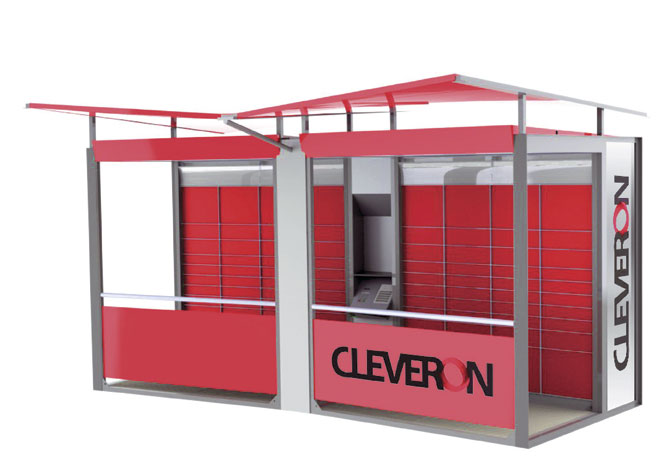
« One has to take into account, the situation, the materials the practicality and uniqueness and after that comes beauty and the art, » stated EAA assistant professor Sixten Sebastian Heidmets.
Drawing: Cleveron
Text: Kristi Leppik
Everyone of us has probably found ourselves in situations in restaurants where we are served drinks in cheap, mass produced, really unsuitable glasses, even when visiting the most posh Estonian restaurants. To avoid this in the future EAA Ceramics and Glass Art Departments have decided to produce Estonia’s own line of dishes – ranging from plates, saucers, goblets, decanters through to sets of dessert dishes.
« Every time I visit Finland, our Northern neighbour, I am envious when I see that small cafeterias, even far out in the countryside uses Arabian made dishes, » lamented Urmas Puhkan, the head of the EAA Ceramics Department. Today Estonian made dishes apparently are not used as they do not yet have a reputation or so called, “image.”
Dishes have been produced in Estonia in the past but this essentially died out when the Soviet regime ended causing good ceramics producers whose products were noteworthy, to shut down. «At that time dishes were created with care and every detail was considered important. Usually a Commission which included artists, technologists and marketing representatives, appraised the products, » recalls Puhkan and added that this attention to detail tradition ceased to exist with the passing of the Soviet Union.
The idea to design a line of dishes for Estonia has been in the air and considered for some time, according to Puhkan. « We have repeatedly tried to reactivate contacts with the declining ceramics production industry, » he stated. In 2006 a competition was created and conducted to find new products. Two were finally chosen and they were supposed to go into production. « Tallinn Ceramics Factory unfortunately changed owners so that effort ended » Puhkan stated. Also over the years some attempts have been made to work with Siimusti but as the firm experienced financial difficulties, tax arrears, this too did not bear fruit.
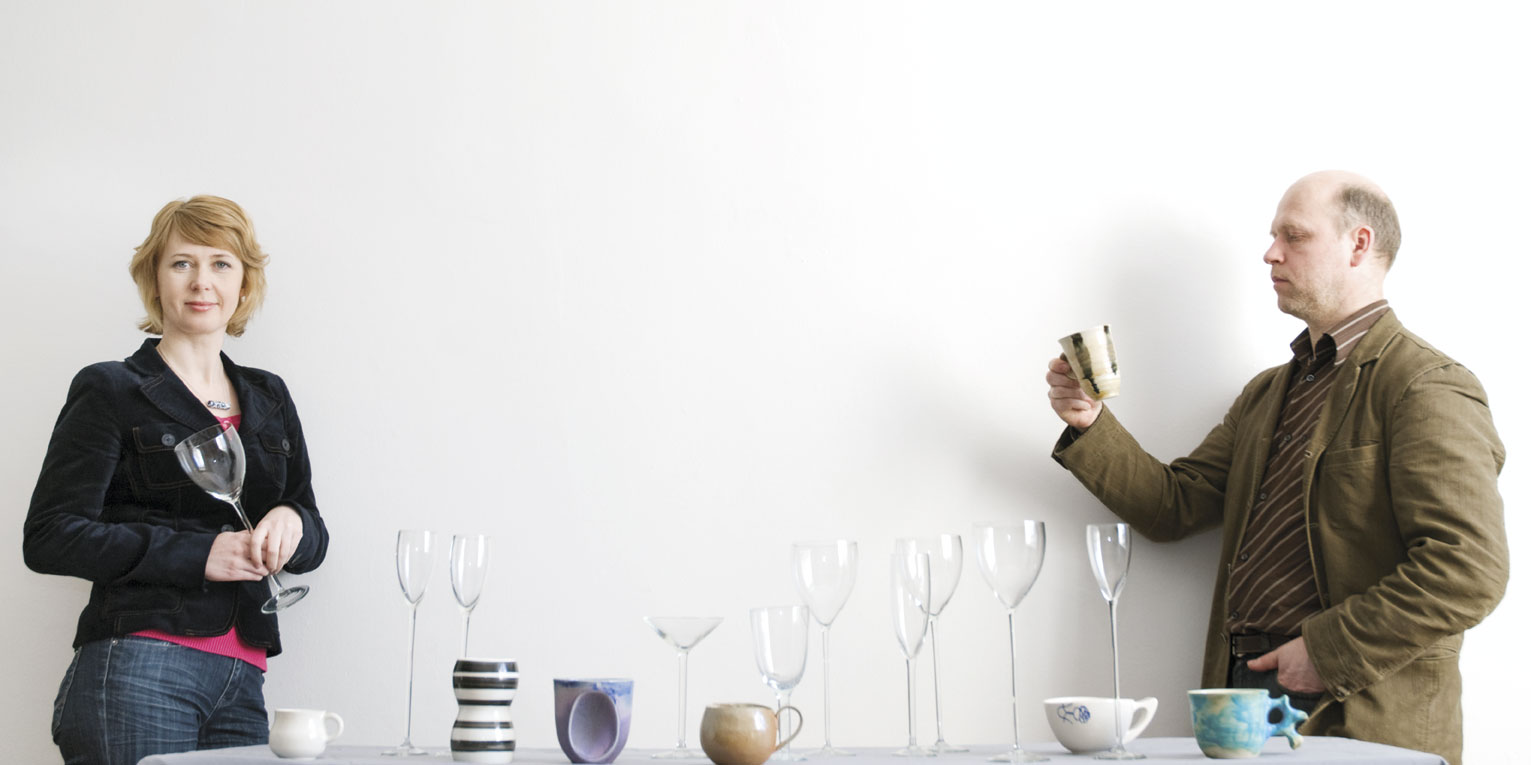
Photo: Karel Koplimets
Today however, Estonian dishes production industry seems to have re-awakened and shows signs of coming to life again. In the Spring of 2011 Puhkan and the EAA Glass Art department’s assistant professor Tiina Sarapu decided, in order to gather data on the situation generate new ideas for producing new dishes, to turn directly to the Estonian restaurant and food outlets owners and proprietors. « The project «Food and Dishes» is admittedly in the beginning stages, as we set out to to aquaint retauranteurs with our creative abilities and capacity to jointly produce products. We wanted to determine exactly what their interests and needs were in order to come up with a suggestions and a plan for working together. This was accomplished through a series of regular meetings and workshops, » stated Sarapu. However, the first real results of this exploration and preliminary joint effort and cooperation will become probably become better known after a year.
The well known Chef, Imre Kose, working at the the now closed Vertigo restaurant stated that good ceramic dishes produced in Estonia would in his view be in demand as the need for this is visibly there. He added « Particularly if there is a desire to pleasantly surprise dining visitors from abroad.» Also he noted, « Dishes can actually be incorporated into aquainting Estonian culture, particularly when combined with the serving of ethnic food. » For this reason EAA Ceramics and Glasss Art students see restaurant owners as their possible primary partners in the joint project. They now want to contact and form partnerships with owners who might be interested in using a line of Estonian created and made dishes in their restaturants and food outlets.
Sarapu directs attention to the need for developing a line of dessert dishes particularly, which could be created especially for a resturant. This could come about through a joint project, where Chefs and Glass Art students work together. « This would be a perfect opportunity to let fantasy fly and then to produce the dishers new technological advances could be explored and be incoporated, » enthused Sarapu.
Puhkan feels that when the three partners, the producer, the food server and the artist come together the result will be unprecedented. « This bringing together of talent would result in a unique shop-kitchen where ideas which have to date been considered rather Utopian, will find new, brilliant but practical solutions. » stated Puhkan.
Sarapu thinks that a line of Estonian created and made dishes could also find acceptance outside Estonia. The dishes would definitely add quality to service in restaurants, bars and be attractive in homes. Serving food and drinks using modern and quality dishes would be certainly be noticed. « What is better or more intersting than displaying a product of high quality and of local design, » he stated optimistically with a bright and produtive future in mind.
Text: Kristi Leppik
Almost every other Church in Estonia requires renovation. In order to to restore the Churches to their former glory the Estonian Academy of Arts ( EAA ) heritage preservation and restoration department gathers information on the history of the Churches and collects information about their conservation needs, in an internet information base.
In answering the question on why Restorers took on such a demanding project, the EAA Heritage preservation and Restoration Department Head in charge of teaching about Art History objects preservation and the Coordiantor of the digital archive «Estonian Churches» Hilkka Hiiop stated, that the information required takes too long and is too much for one person to handle. One piece of information can be found in one archive and another yet in another – information is spread out. « It is necessary to dig deep into files and documents,» she explained. This is where the idea came from, that if the information was properly gathered and found by the restorators in one data base they could quickly get to doing their work activity of restoration. This permanent data base makes the information available to anyone interested, certainly professioal restorers and possibly even intrested tourists.
To the present day the digital data base contains information on Churches in Saaremaa, Harjumaa and Läänemaa. Work is in progress for Churhes of Järvamaa and Hiiumaa. « An additional pleasure with the data base is that it can be updated regularly, with new information and names of persons involved in the field, » stated Hiiop about the advantages of the digital base.
Since there are many Churches in Estonia the focus by the Restoraton Department students is to gather information primarily on what are considered historically important county Churches and those found in the cities.
But how is this information gathered? Hiiop gave a simple description of the process. During the school year the Second year students become aquainted with the material in the archive files. This is followed with a Summer practical placement where the Churches are visited personallly to ensure the accuracy of the data collected in the archive. « Illustrations and exterior photos are taken, including panoramic pictures which allow at 360 degree view of the object and site,“ stated Hiiop.
As distinct from archologists the Restorers do not look for or expect to find anything new and startling because the primary goal of the excercise is only to get the information which is spread out, dispersed, gaterhed into one place. But there have been instances where restorers have become involved and carried out their own more detailed, in-depth studies, on the object because it is interesting to them For example in connection with the Valjala church they became involved when studying the Painting of the Apostles in pigment analysis and which yielded new information. «This finding resulted in discussions which questioned the existing old theories and led to developing new theories of Art History » Hiiop explained with enthusiasm.
Findings of this nature and other research create more interest in the objects by the Restorers. «Students learn to analyze and evaluate previously conducted restoration work, » admits Hiiop. She emphasized that Church Restoraton is a complex and multi-faceted undertaking taking place at many levels. « It is an extremely complex activity where the maximum results are not guaranteed, » stated Hiiop. This is becasue the conditions which the restoration work depends on are diverse and consists of a number of variables. « For example the changing temperature and the climate within a Church which can damage restored paintings.»
The more interesting finds create in Restorers a greater passion for restoration – an attitude of - lets get going! « But this passion has to be kept in check because any personal and unplanned initiative can be damaging to historical materials and objects and frequently the damage is irreversible» stated Hiiop.
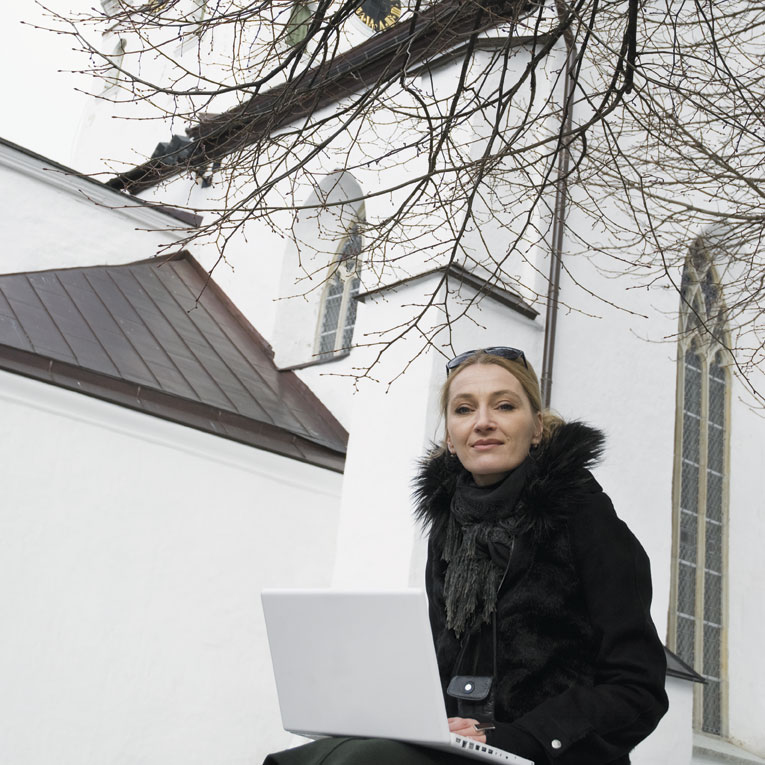
Photo: Karel Koplimets
«Estonian Churches»
* The goal of the Digital Archive is to bring together in one place the data base, the histories of Churches and preservation related information.
* The Archive was created by the EAA heritage conservation and retoration department. But if there are people intersted in Church history and want to particiate in this project they are more than welcome to join us.
* At this time the histories and data on important county and city Churches are being gathered. Churches built in counties prior to 1917 are focused on in the index of the data base.
To date information on Churches of Saaremaa, Harjumaa and Läänemaa have been entered into the base. The Data Base can be found at the address - kirikud.muinas.ee Sources: kirikud.muinas.ee
Text: Kristi Leppik
Time is scarce and valuable. For this reason enterprise Monsvile OÜ members Roman Melsas and Stanislav Ivanov have aquired a new T- shirt portal through which a client can buy a T- shirt which the client by using the computer program designed and tailored him or herself.
The result is just as if your own tailor had sewn the T shirt using the correct measurements, produced a creation which pleases and has matching accessories. The only difference between this personal and computer approach and the work of an custom tailor is that the T shirt is in fact produced using a technical and mass production method. This solution saves time for all involved, making it unnecessary to make weekly visits to the tailorshop. It suffices to accept the package when the product is finished and delivered to your doorstep.
In order for this innovative idea to become widely accepted Melsas and Ivanov think that the key word in this process is “visualization”. Although the client only sees their future T shirt on the computer screen it will give the person a very realistic image of what the shirt, created by the client, will look like when it is finished. This is an interactive and participatory approach.
Since someone had to first transfer the innovative idea to use in a computer the Monsvile people turned to EAA. Ms Kadri-Maria Mitt accepted the challenge to find the best way to visually show the component parts of the T shirt. The parts which the client could then use to create his/her own model. Ms Mitt stated « It is important that the shirt be attractive, realistic and the process producing it effficient. We are not dealing here with a one time effort, a completed act, but with an ongoing process as the initial choices made require modifications and this has to be easily manageable.»
This means that it was necessary to „visually“ design and show on the internet page various collars, sleeves, fittings and cuffs. In response to the question, how easy would it be for a young designer to use such a web solution? she answered, that it is a challenge which a person would be able to meet easily, particularaly since if at school the person is able to contact and consult with others working at various specialties. She added « It is only necessary to to press a few buttons and browse on the net.»
The more difficult side Ms Mitt thinks is the technical. She admitted that in this instance there will be more involvement with the technical side than usually encounterd in designing. Further she thought it essential for the person using the method to have an ability to consult with and relate to others, as otherwise the projcet simply might not come about.
«Definitely, this type of project will give young persons a very valuable creative experience, particularly so because it is necesary to consult in order to cut down wasted time, when focusing on insignificant details,» stated Ms Mitt and added that at EAA a basic approach to creation and learning is to show and share a partially finished work, to consult and discuss matters with project leaders to find solutions together and not «arrive with a completed and in your own view a super accomplishment, for evaluation by the teacher.»
For Ms Mitt it seems that there is a sign on the part of entrepreneurs that they want to work together in cooperation with EAA students. «In my opinion this development is welcome and that students like this approach.» At the same time Ms Mitt thinks that it is important to determine what motivates the entrepreneurs to use the school. Is it with a sincere desire to come up with something new and novel or just to cut costs. «The novelty that student participants offer is welcome to them but the idea that an entrepreneur would simply use the students for thier own finanical gain obviously is not ».
Text: Kristi Leppik
Could it be considered an accident or luck when Marko Tõll, one of the founding members of a firm named Moshi, became unemployed last year. His unemployment and a partnership with Kristine Kivi resulted in the creation of Moshi the ecoproducts series. Turning to studetns at the Estoinian Academy of Arts for help they created a new image for the product which was simple and yet distinct.
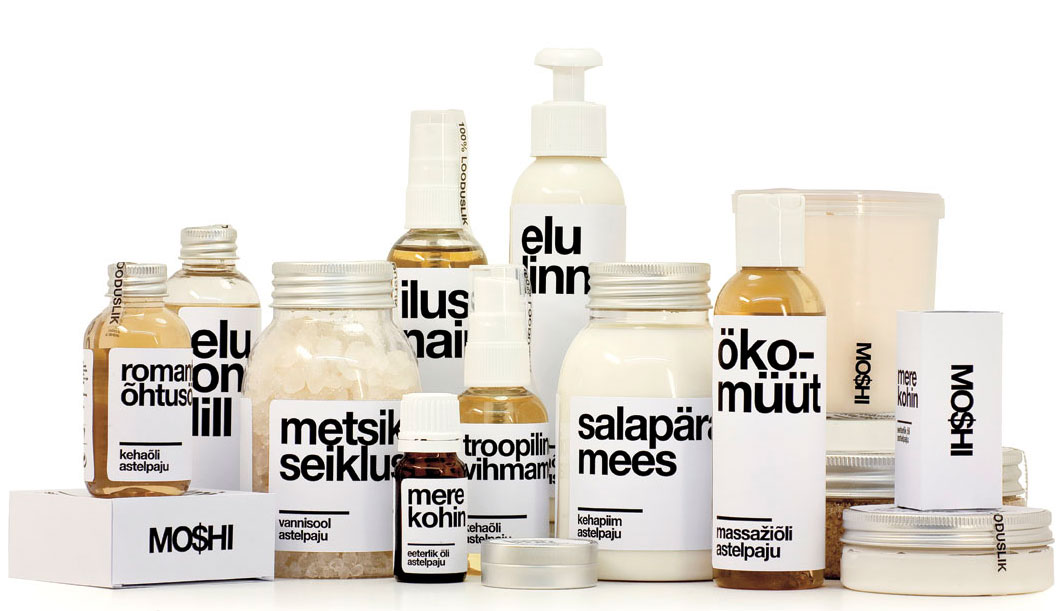
Photo: Norman Orro
Those last two words, simple and distinct are just what characterizes today’s product design, according to the EA: product design department Chairman, professor Heikki Zoova. «Everyone wants their product to be distinct, » he stated. But this is not as easy to bring about as it seems that in product design everything has already been tried. It is difficult to try to find something which is new and interesting, it is a challange to practioners in product design and was to the students of EAA.
To be simple and distinct – it is difficult to find a harder word combination according to EAA III year student, one of the Moshi image creators, Sylvia-Johanna Annus. This combination was at the base of the requirement set out for designing the Moshi brand. «It was necessary to be able to identify instantly what Moshi stands for,» added professor Zoova. It must be understood that Moshi means an ecological body cream product. It must be immediately identified by the buyer as an ecological body cream and not just some dish washing product or flower seeds.
The Moshi producers, Tõll and Kivi explain that Moshi produces a natural and organic body care product, soap as well as soja-wax candles. At ths time the products are for sale only in Pärnu, but in the very near future an internet store will be opened and in the farther future the products will be on sale in shopping malls.
How did the young people come up with the idea – to start producing eco products ? « Life threw us a curve and but by accident or luck Marko became unemployed, » recalls Kivi. They then began to explore what they could become involved in producing to create employment. They came to soaps and candles. «Why and how such a thought came to them is a mystery which they still cannot explain today, » admitted Kivi.
After creating a business plan they reached a tight spot or a bottleneck, trying to come up with a unique image and design for the products of the enterprise to make them distinct from the products of the competition. «We found EAA through the Enterprise Estonia (EAS) which supports innovation, » Kivi stated. This along with the EAA product design students, Annus and Ingela Viks, graphic design department student Norman Orro resulted in the creation of the visual identity and package design solution. « Their assignment was the development of the Moshi OÜ image, the logo and web page which was to be in harmony with the package design solution, » added Kivi.
Although at this time the EAA student designs for the bottles and jars with Moshi labels cannot yet be found in the malls, the producers are satisfied with the results – Moshi catches attention with the fact that it is clean and simple and the packaging is distinguishable from the products of the competitors. « We are very satisfied. There has been a lot of positive feedback. The creation is simple and great, everything is simply black and white, black lettering on a white background, » states Kivi, not able to hold back her enthusiasm when describing the product.
In answer to the question, is such a project hard or simple for students? Kivi responded saying that it certainly is not easy. «To start with it requies a considerable amount of start up money, time and a whole lot of patience, » she stated. She admits that to start up such an enteprise the producers have to know how to set up a new business and where to get support for it as well as how to be innovative.
The Moshi producers applied for support from the uneployment fund which backs starting up businesses and the innovation support came from EAS. « Both have been of tremendous help to us. Without their help we would not be as far as we are today, » added Kivi.
Text: Kristi Leppik
Estonian Academy of Arts (EAA) textile design department Chair professor Mare Kelpman states that the present is an interesting period of time in the field of textiles, for designers and producers – as new materials are being created and their development is taking pace faster than ever before.
Why are we talking about textile design as art when the practical aspect is really predominat?
The textile design area has in it many different sub-areas. By looking at the Master’s themes of student graduating last Summer we get a glimpse of the full ampule: therapy items for children’s hospitals, interactive wall paper, methods for printing cloth with plant colours, clothing collection design for MAKI brands, theoretical research and a system created for a collection of textiles useful in decorting architechtural exteriors.
What is EAA able to offer - what is the textile design department doing in its area compared to earlier times?
The EAA textile design department has the ability and means to design, develop new products and prepare them for production.
What have been the most recent advances in the area of textiles?
The area of textiles is rather broad, beginning with cloting and interior design, reaching architecture, machine production for the defense industry, smart textiles etc. The development of specific new textile materials is taking place more and more intensively than ever before. The reason is that on the one hand there are fewer natural raw matrials available to use and its cost has risen. On the other hand science and technology has made it possible to develop textiles which can successfully replace strong and durable materials, for example steel. New materials have the additonal characteristics and add value in that some are self-cleaning, heat up and are non-flammable and quickly biodegradeable.
In your opinion, as a textile artist, has the field recently taken on more of an applied arts emphasis?
Design deals with problems, which may be specifically internal to the field or for the user. Art reflects a creator’s ego and world vision expression. Applied art is an outdated expression. Often the label refers to items which are not practical or useful.
But what do you see as more in demand by the market, more design or practical items?
I believe that going in both directions the producer can find a market but those segments of the market are naturally different.The Estonian market is too small for combining both directions.
We all use textile consumer products daily however many probably are not aware of the number of hours it has taken to produce the items, the materials and appreciate the quality of the work. Products coming from the far East using labor which is less expensive has to some extent clouded our understanding of the process of manufcturing of the products, keeping the true value hidden. Even China cannot continue to produce products at the present low cost forever.
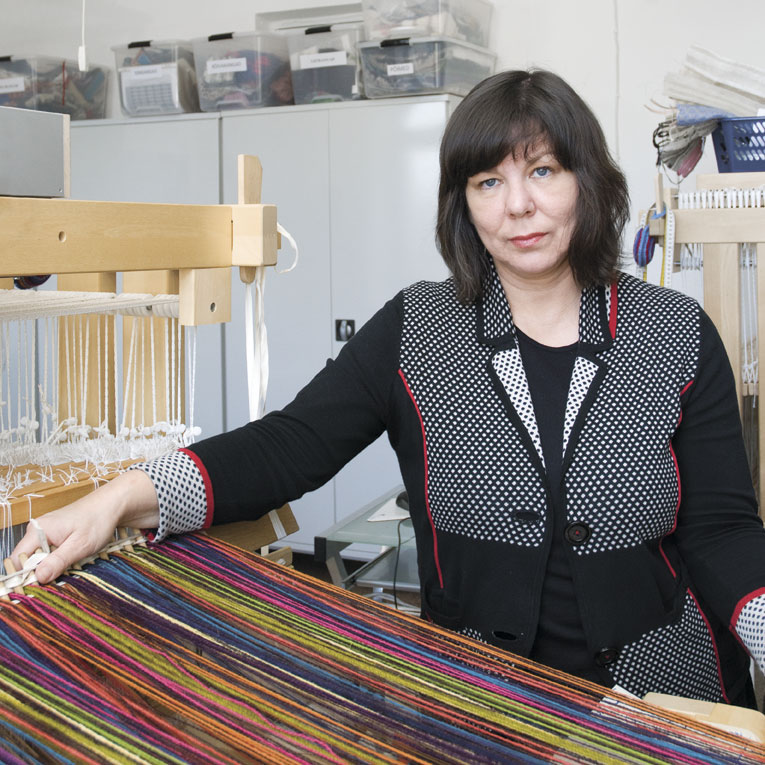
Photo: Karel Koplimets
In recent times many Estonian textile manufacturers have closed their doors, what does this indicate?
New owners in buying plants seem to have been more interested in realizing the real estate value than investing in the skills of their workers. Textile production requires the same strategic skills as bread baking for example which have to be maintained and preserved. This reality has been recognized by many European countries and with the help of the European Union they have created small innovative enterprises which conserve the skills of the past and develop the textile production methods on this basis. I emphasize that the indvidual craftsman weaver does not have the skills which are needed for mass manufacturing and production.
You are a proponent for a number of projects which brought to textile design a nanotechnolocial direction but is this not the domain of engineers?
The EAA textile design department has dealt with the so called smart or interactive textile area since 2005. In May of this year 2011, we will show the work of our students in Frankfurt, at a large internatioal fair Technotextile Showcase. This area will definitely be a trend in the future and in order to produce a good product cooperation among scientists, engineers and designers is necessary. Our Ph.D candidate Kärt Ojavee is working on this with the Tallinn Technical University doctors candidates and engineers at the Bio Robotic Centre.
The social component of design also has a prominent place in the future as textiles and particularly by using interactive textiles it is possible to create essential textile products for persons with disabilities and for use in therapies.
Last year the Master’s thesis of Liis Koort received international recognition for focusing on tactile textiles to be used in therapy for children whose sense of feeling has been diminished or lost. This work was recognized in China where an international association, the Cumulus, in its social design competition awarded the paper third prize. The Tallinn Children’s Hospital therapeutic use of textiles has been in effect for almost a year and has received a high praise from specialists in the field.
But we do not deal with nanotechnology yet and leave the field to scientists and engineers. At the same time I try to keep informed about what is taking place in the field.
What is your opinion what is required for good cooperation to take place between a school and entrepreneurs?
From entrepreneurs we expect that their ideas and wishes are well thought out beforehand before turning to us. The enterprise personnel gives the input/content in order to solve the problem. If however this is not the case and the business has not prepared itself fully and properly, especially on what is expected of the designer, no solution or productivity can be expected to come from the contact.
Looking from the perspective of the entrpreneur or giving advice to the entrepreneur, how would the person ecognize the moment that, now is the right time to turn to the textile designer for advice?
When the assigment is clear in their own minds, then the sooner the better.
Anne Pikkov
Director EAA Open Academy
For the simple reason that the present economic downturn has to be turned to advantage! A glance has to be directed to the enterprise, find ways to deal with new areas, how new products and services are created in order to make the firm more competitive. First of all there needs to be an appeal to emotions of consumers and then attempting to satisfy their expectations in a better way.
The entreprenuer can facilitate the creation of a fertile ground for new innoavtive ideas and quality products by being open to new trends and information. This would not require significant investments, but might be the answer to getting moving. The focus should be on self-fulfillment and development which «in good times» seemed to be unneessary, since everything was naturally progressing up and in a positive direction.
There is no simple successful solution. But here are examples of many entrepreneurs who have in the course of development achieved new qaulity.
Last Fall a Tallinn firm which sells luxury interior products came face to face with the truth that in order to attract buyers it was necessary to offer more than just name brands. There were few customers and those who did come were very knowledgeable and particular. This forced them to try to find ways to offer clients more than just the usual sales approach.
The Open Academy designed a program and course and offerd it before the workday began to salespersons. The subjects covered composition, colour in design, the understanding of the principles of design and creation of projects. Today the attitude to work and approach to sales by the salespeople has changed. They saw it as a development opportunity. Service reached a new level of excellence and clients of the firm have recommended that the approach be adopted by other enterprises.
Creativity is not an exclusive sphere of interst only to artists. In the EAA continuing education department an opportunity was offered to everyone who wanted to study in a new specialty or are doing something in an area involving creativity. Courses have been designed for intensive study but which are conducted in stress-free environment. Significant is not only the fact that the courses take place in a pleasant atmosphere but also that there is the possibility of meeting other people representing a range of occupations and professions and coming from other countries.
An increase in creativty can also be seen from the fact that enterprises in their activities and undertakings want to include some form of art education. For example it has been stated by Inga Berkovitch from the Sampo Bank : « The idea of a course in painting began as a desire to do something entirely different from daily activities. Since our partners deal with sales which is an art in itself, we decided to have them create “real“ art. Under the leadership of Tiina Tammetalu pictures were produced by the salespeople which now hang on and decorate the walls of their conference room.»

Photo: Karel Koplimets
Make a start at the Summer Academy!
suveakadeemia.artun.ee
The time for making new plans is coming this summer.
In the begining of May the opportunity rich Summer Academy opens its doors. It is possible to choose various art and design courses. Interesting parts of Art History, painting, ceramics, summer cottage design and clothes design are but some of the courses offered.
Our teachers are the best in their own fields who can make the studying process a real pleasure, even to those who have not dealt with Art education before in their lives.
For those who want to add to their education and acquire new knowledge and skills for working in a new area we offer one year courses in Interior Design, Graphic Design, Photography, Ceramics, and Restoration. These are ideal for those who want to acquire a new spcialty while working.
Creativity exists in all of us – without borders and exiting. Give creativity a chance to emerge and so that we can become emotionally richer!
For additional information: www.artun.ee/avatudakadeemia
Tel 6 267 326